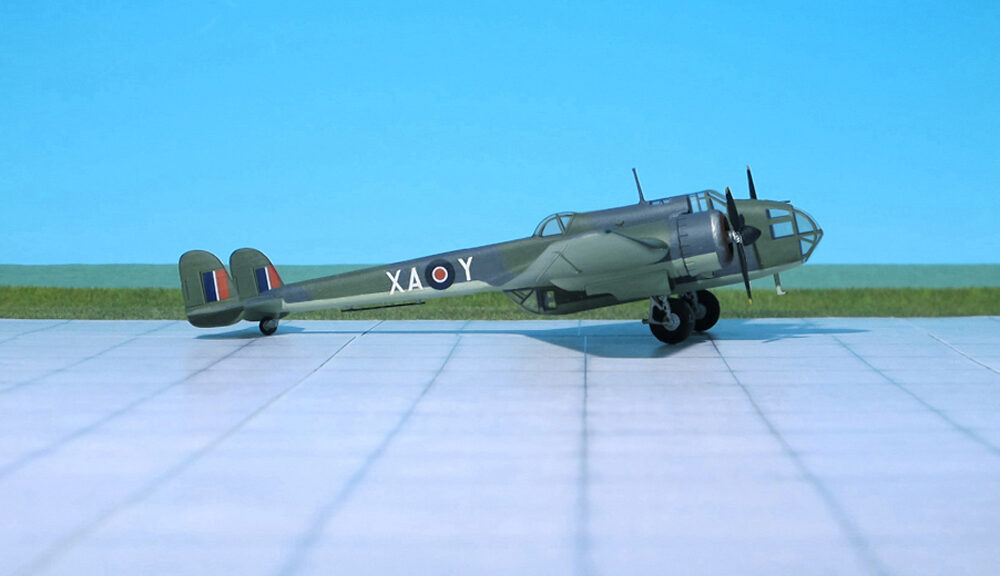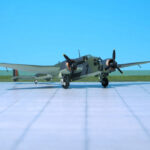TYPE: Medium bomber, torpedobomber
ACCOMMODATION: Crew of four
POWER PLANT: Two Bristol “Pegasus” XVIII radial engines, rated at 1000 hp each
PERFORMANCE: 247 mph at 13,000 ft
COMMENT: The Handley Page HP.52 Hampden was a British twin-engine medium bomber of the Royal Air Force (RAF). It was part of the trio of large twin-engine bombers procured for the RAF, joining the Armstrong Whitworth Whitley and Vickers Wellington. The newest of the three medium bombers, the Hampden was often referred to by aircrews as the “Flying Suitcase” because of its cramped crew conditions. The Hampden was powered by Bristol Pegasus radial engines but a variant known as the Handley Page Hereford had in-line Napier Daggers.
The Hampden served in the early stages of the Second World War, bearing the brunt of the early bombing war over Europe, taking part in the first night raid on Berlin and the first 1.000 bomber raid on Cologne. When it became obsolete, after a period of mainly operating at night, it was retired from RAF Bomber Command service in late 1942. By 1943, the rest of the trio were being superseded by the larger four-engined heavy bombers such as the Avro Lancaster and Handley Page Halifax.
The Hampden Mk I had a pilot, navigator/bomb aimer, radio operator and rear gunner. Conceived as a fast, manoeuvrable “fighting bomber”, the Hampden had a fixed forward-firing Browning machine gun in the upper part of the fuselage nose. To avoid the weight penalties of powered turrets, the Hampden had a curved Perplex nose fitted with a manual Vickers K machine gun and a Vickers K installation in the rear upper and lower positions. The layout was similar to the all-guns-forward cockpits introduced about the same time in Luftwaffe medium bombers, notably the Dornier Do 17.
The Hampden had a flush-rivette stressed skin, reinforced with a mixture of bent and extruded sections in an all-metal monocoque design. A split-assembly construction technique was employed: sections were prefabricated and then joined, to enable rapid and economic manufacture. The fuselage was in three big sections – front, centre and rear – that were built using jigs The centre and rear sections were made of two halves, which meant that the sections could be fitted out in part under better working conditions prior to assembly. All possible assembly work was performed at the benches prior to installation upon each aircraft.
The wings were made up of three large units: centre section, port outer wing and starboard outer wing, which were also subdivided. Each section was built around a main girder spar, leading edge section and trailing edge section. The wing made use of wingtip slots and hydraulically-actuated trailing edge flaps; the flaps and ailerons had stress-bearing D-spars. The configuration of the wing was a key feature of Hampden, being highly tapered and designed to exert low levels of drag; these attributes were responsible for the aircraft’s high top speed for the era of 265 mph while retaining a reasonably low landing speed of 73 mph.
The Hampden’s flying qualities were typically described as being favourable; It was extraordinarily mobile on the controls. Pilots were provided with a high level of external visibility, assisting the execution of steep turns and other manoeuvres. The control layout required some familiarization, as some elements such as the hydraulic controls were unassuming and unintuitive. Upon introduction, the Hampden exhibited greater speeds and initial climb rates than any of its contemporaries while still retaining favourable handling qualities.
The slim and compact fuselage of the aircraft was quite cramped, wide enough only for a single person. The navigator sat behind the pilot and access in the cockpit required folding down the seats. Once in place, the crew had almost no room to move and were typically uncomfortable during long missions. Aircrews referred to the Hampden by various nicknames due to this, such as Flying Suitcase, Panhandle, and Flying Tadpole.
The last Bomber Command sorties by Hampdens were flown on the night of 14/15 September 1942 by 408 Squadron, RCAF against Wilhelmshaven. After being withdrawn from Bomber Command in 1942, it operated with RAF Coastal Command through 1943 as a long-range torpedo bomber. These Hampden TB Mk I had a Mk XII torpedo in an open bomb bay and a 230 kg bomb under each wing. Furthermore, the Hampdens were in action as maritime reconnaissance aircraft. Between 1936 to1941 a total of 1,430 Hampdens were built; 500 by Handley Page, 770 by English Electric, and 160 by Canadian Associated Aircraft (Ref.: 24).












